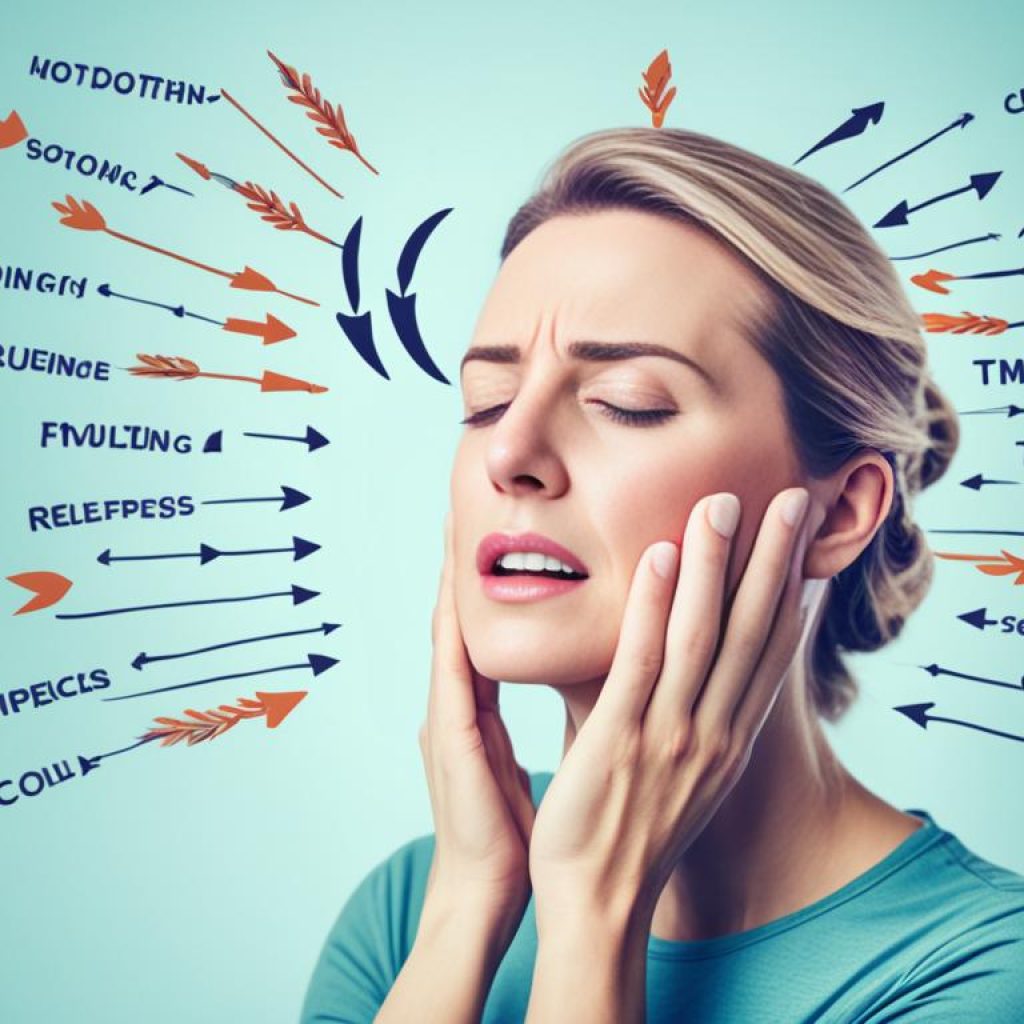Migraines are more than just headaches. They make life harder for millions with pain, nausea, and sensitivity to light and sound. Many are now choosing natural remedies and holistic methods for relief and prevention.
Key Takeaways:
- 1 in 7 people worldwide suffer from migraines, highlighting the widespread impact of this condition.
- Natural migraine remedies can complement existing treatments and provide alternative options for relief.
- Holistic migraine treatment approaches focus on lifestyle changes and addressing underlying triggers.
- Herbal remedies, pain management techniques, stress reduction methods, and sleep hygiene can all play a role in managing migraines.
- It is important to consult with a healthcare professional for personalized recommendations and guidance in managing migraines.
Curb the Caffeine
If you often get migraines, you’ve likely heard differing views about caffeine’s effect. Coffee, tea, soda, and other drinks with caffeine might seem like they help. They are thought to narrow blood vessels and lessen inflammation. Yet, caffeine’s connection to migraines is quite complicated.
While caffeine can provide temporary headache relief for some individuals, it can also trigger rebound migraines in others.
Noticing that caffeine makes your migraines worse means you should cut back or stop having it. Doing this can help you avoid rebound migraines. It also aids in achieving better relief for the long run.
| Caffeine and Migraines | Caffeine and Headache Relief | Caffeine as a Migraine Treatment | Caffeine Sensitivity and Migraines |
|---|---|---|---|
| Caffeine can trigger rebound migraines in some individuals. | Caffeine can temporarily relieve headache pain by narrowing blood vessels. | Using caffeine as a migraine treatment may not be effective for everyone. | Some people may be more sensitive to the effects of caffeine, which can worsen migraines. |
Manage Your Pain Meds
Using pain relief meds more than twice weekly may cause medication overuse headaches, also known as rebound headaches. This issue can happen with all kinds of painkillers, even those for migraines. To break free from this cycle, looking into other ways to manage pain is key.
Pain meds offer quick relief but aren’t a long-term solution. Using them too much can make headaches worse and more common. Finding the right mix of immediate relief and long-term migraine control is essential. This means not just depending on drugs.
For managing migraines, you can try lifestyle changes, non-medication methods, and prevention. Mixing these with specific migraine treatments can lead to better headache control. This also means less need for pain meds.
Identifying Triggers and Lifestyle Modifications
Spotting triggers and changing your lifestyle is vital for less migraine medication use. A migraine diary helps spot patterns and triggers like food, stress, or sleep loss. Avoiding these triggers can lower migraine numbers and intensity.
Migraine management is about more than just acute pain relief. It involves lifestyle shifts that tackle migraines’ root causes. Identifying triggers and making changes can offer lasting relief without leaning on pain meds.
Non-Drug Therapies and Supportive Techniques
Various non-drug options exist for migraine pain management. These options include:
- Relaxation strategies: Techniques like deep breathing and muscle relaxation help lower stress and ease migraine pain.
- Physical therapy: A therapist can tackle muscle issues and tension linked to migraines.
- Cognitive-behavioral therapy: This therapy changes negative thoughts, manages stress, and builds coping skills.
Exploring other methods like acupuncture, massage, and chiropractic care is useful too. These can lessen migraine frequency and are alternative to meds.
Preventive Measures and Supportive Lifestyle Changes
Prevention is key in reducing migraine frequency and drug use. Steps include:
- Regular sleep patterns: Consistent sleep helps avoid migraines.
- Stress management: Activities like meditation and yoga lower stress, preventing migraines.
- Healthy living: A balanced diet and staying hydrated support migraine control.
Adding these preventive steps and lifestyle changes helps in migraine control. It means not having to rely on meds so much.
Watch the Weather Forecast
Sudden weather changes can trigger migraines for some. It’s key to know about coming weather patterns. This helps prevent migraines during extreme weather.
Here’s what you can do:
- Take migraine medicine early: If a headache starts and you think it’s weather-related, take your migraine meds right away. This step can ease your symptoms and might stop a migraine from getting worse.
- Live healthily: A healthy lifestyle can help your body fight off migraines caused by the weather. Sleep enough since lack of sleep makes you more prone to migraines. Also, eat well and stay active to reduce your migraine risk.
Being proactive helps you lessen weather-related migraines effects on your life. Don’t let the weather affect your health.
| Weather conditions | Potential migraine triggers |
|---|---|
| Changes in barometric pressure | Increased headache frequency and severity |
| Extreme heat or cold | Prolonged migraines with associated symptoms |
| High humidity | Worsened headaches and increased discomfort |
Table: Weather Triggers for Migraines
Find Ways to De-Stress
Managing stress is key for keeping migraines at bay and staying well. Stress often triggers migraines and can make pain worse. By adding stress-lowering activities to your day, you can keep migraines under control and boost your life quality.
Relaxation Techniques for Migraines
- Yoga: Regular yoga can ease stress and tension. This makes it a great way to relax and keep migraines away. Through gentle moves, deep breaths, and staying present, yoga helps you chill and cuts down on migraine frequency and pain.
- Meditation: Making meditation a part of your life can quiet your mind and lower stress. Practicing mindfulness or other meditation ways can better your migraine management and bring relief.
- Breathing Exercises: Deep breathing can trigger the body’s chill-out mode, lowering stress and making migraines less severe. Trying simple methods like belly breathing or alternating nostril breaths can help.
- Tai Chi: Tai chi mixes smooth movements with deep breaths. It’s a soft exercise that lowers stress, promotes relaxation, and boosts wellness, great for handling migraines.
- Prayer: Praying or following spiritual habits can give a feeling of calm and peace. This helps ease stress and control migraines.
Finding relaxation methods that suit you is crucial. Adding these habits to your daily life can lower stress, ward off migraines, and better your mental and physical health.
Regular physical activity is also a strong stress manager and can make migraines less harsh. Working out releases endorphins, which are nature’s happiness boosters. This can lift your mood and cut down on stress. Enjoyable activities like walking, yoga, or sports can positively influence your migraines and stress levels.

Set a Sleep Schedule
Too little or too much sleep can lead to migraines. It’s vital to have a regular sleep schedule to help lessen migraine symptoms and boost your overall health. By focusing on good sleep habits, you can make your surroundings more conducive to sleep and foster better sleep practices.
1. Consistency is Key
Stick to a set bedtime and wake-up time, even on weekends. This habit keeps your internal clock steady and supports a regular sleep cycle. Aim to get between 7 to 9 hours of sleep each night. Enough rest can help lower the chance of migraine attacks from sleep issues.
2. Create a Sleep-Friendly Environment
Turn your bedroom into a place designed for sleep. This means less light, minimal noise, and a cool room temperature. You might use blackout curtains, eye masks, earplugs, or white noise machines to make your bedroom quiet and tranquil. A cozy mattress and pillows are also key for good sleep alignment and comfort.
3. Minimize Electronic Device Use
Electronic gadgets give off blue light, which can mess with your sleep pattern. Try not to use phones, tablets, and computers for an hour before bed. If you have to use them, wear blue light glasses or switch on the night mode to cut down on blue light.
4. Wind Down Before Bed
Set up a calming routine before bed to tell your body it’s time to sleep. Calm activities like reading, a warm bath, meditation, or soft music are good choices. Avoid active or intense exercises before sleep as they might make it hard to doze off.
5. Avoid Stimulants
Keep your caffeine intake low and don’t have it near bedtime. It can make falling asleep tough and ruin sleep quality. Watch out for caffeine in some medicines and chocolate. Also, steer clear of big meals, alcohol, and nicotine before bed since they can mess up your sleep cycle and cause migraines.
6. Keep a Sleep Diary
Use a sleep diary to keep an eye on your sleep patterns and when you get migraines. Write down how long and how well you sleep, along with anything that might affect your migraines like not sleeping enough or oversleeping. Spotting trends can help you adjust your habits for better sleep and fewer migraines.
Building a consistent sleep schedule and adopting these sleep practices can help improve your sleep pattern and lessen migraine risks from sleep issues. Always talk to your healthcare provider for advice that fits your unique needs.
| Sleep Hygiene Tips for Migraines |
|---|
| Set a regular bedtime and wake-up time |
| Create a sleep-friendly environment with reduced light and noise |
| Avoid electronic devices before bedtime |
| Establish a relaxing bedtime routine |
| Limit caffeine intake and avoid stimulants close to bedtime |
| Keep a sleep diary to track sleep patterns and migraines |
Track TMJ
Tight muscles in the TMJ area often lead to migraine pain. Watching for TMJ signs can help with jaw tension and lower migraine chances. Here’s how to ease jaw tension:
- Try gentle neck stretches: Ease jaw tension by gently stretching neck muscles. Start by slowly tilting your head right, hold, then do the left side.
- Massage the jaw hinges: Gently press and massage near your ears, at the jaw hinges. This relaxes TMJ muscles, easing tension.
- Avoid excessive gum chewing: Too much gum chewing strains jaw muscles, increasing tension. Chew less gum or choose sugar-free to avoid jaw migraines.
- Practice good posture: Good posture helps reduce jaw tension. Align your head with your neck and shoulders, avoiding bending or slouching.
- Sleep on your back: Back-sleeping keeps your jaw neutral, lessening clenching or grinding your teeth at night. It helps avoid TMJ migraines.
Adding these methods to your daily habits can help manage TMJ migraines and bring relief.

“Correct jaw alignment and relaxation methods can really cut down on migraines from TMJ issues.” – Dr. Sarah Thompson, Dentist
Explore Acupuncture or Acupressure
If you’re exploring alternative migraine treatments, consider acupuncture and acupressure. These therapies might offer relief without the need for migraine medication, especially for those wary of side effects. They aim to manage migraine symptoms effectively.
Acupuncture for Migraines
Acupuncture, a traditional Chinese treatment, uses thin needles at certain body points. It aims to improve energy flow and promote healing. For migraines, it might help in preventing, reducing frequency, or lessening intensity.
Studies show acupuncture could boost endorphin release, aiding in pain relief. It might also enhance blood circulation, decrease inflammation, and correct energy imbalances along meridians.
“Acupuncture involves the insertion of thin needles into specific points on the body. It may help prevent migraines and provide relief by stimulating the release of natural painkillers and rebalancing the body’s energy pathways.”
Licensed acupuncturists, with their extensive training, perform acupuncture. The needles are thin, making the process virtually painless. Many find acupuncture both relaxing and invigorating.
Acupressure for Migraines
Acupressure is akin to acupuncture but uses manual pressure instead of needles. It’s easy to learn for home use, offering a handy migraine management tool.
Applying pressure to specific points can boost energy flow, easing pain and tension. It’s useful for instant relief or as a preventative strategy.
One method involves pressing the LI-4 point, between thumb and index finger. A circular massage here might lessen migraine symptoms for some.
Although effective for many, acupuncture and acupressure aren’t universal cures. Consulting a professional is advised to assess suitability for your condition.
For certified acupuncturists or more on migraine acupuncture, visit the National Certification Commission for Acupuncture and Oriental Medicine website.
| Advantages of Acupuncture | Advantages of Acupressure |
|---|---|
|
|
Sniff Peppermint or Lavender
Some strong smells can set off migraines in certain people. To ease pain and help relaxation naturally, keep peppermint and lavender oils around for aromatherapy. These oils are known for their pain-relieving and calming properties.
Peppermint oil can help reduce headache pain. Lavender oil, on the other hand, might ease anxiety that comes with migraines. Using these oils can offer aromatherapy benefits for migraine management.
When trying out alternative therapies, be mindful of allergies. Always mix essential oils with a carrier oil before skin application. Also, check with a healthcare provider to make sure these oils are right for you.
Evidence from Studies:
“Aromatherapy has been around for a long time, used in many cultures for relaxation and well-being. Studies have looked into peppermint and lavender oils for migraine relief. Early research shows they might help with pain and relaxation as part of a holistic treatment plan.” – Integrative Health Journal
Tips for Using Essential Oils:
- Pick high-quality oils from trusted sources.
- For aromatherapy, either use a diffuser or directly sniff from the bottle.
- Before skin application, dilute oils with a carrier oil like coconut or almond oil.
- Apply a diluted mix of peppermint or lavender oil on your temples or neck for relief.
- Try different oils to see which ones best help you with migraines.
Remember, essential oils are to support, not replace, standard migraine treatments. They should be used along with professional medical advice for symptom relief and relaxation. Always talk to a healthcare expert before trying new treatments.
Unwind With Yoga
Looking for a natural way to fight migraines? Try yoga. It’s shown to help lessen migraines by reducing their frequency and intensity. It’s a great natural option for those seeking relief. Plus, yoga boosts both physical and mental health.
The Benefits of Yoga for Migraines
Yoga tackles migraines from all angles, improving both your body and mind. Here’s how it helps:
- Migraine Frequency and Intensity: Studies say yoga can greatly cut down on migraines. Regular practice makes headaches less frequent and milder.
- Pain Relief: Yoga eases migraine pain by loosening up tension, boosting blood flow, and helping you relax. Its exercises reduce muscle tightness and pain.
- Stress Reduction: Stress often brings on migraines. Yoga’s deep breathing and meditation can lower stress. Managing stress might help avoid or lessen migraines.
- Mood Improvement: Migraines can make you feel depressed or anxious. Yoga brightens your mood and fights these feelings. Regular practice enhances your mental well-being.
Yoga as a migraine remedy can also mean relying less on medicines. It offers a whole-body approach, taking care of both your physical and emotional health.
How to Incorporate Yoga into Your Routine
Want to use yoga for migraine relief? Here are some tips:
- Find a Qualified Instructor: Look for a yoga teacher experienced with migraines. They can suggest the best poses for relief.
- Practice Regularly: Make yoga a habit. Try doing it for 20-30 minutes, three to four times a week for real benefits.
- Focus on Gentle Yoga: Pick mild yoga styles. Migraines can make you sensitive to light and sound. Gentle yoga won’t worsen symptoms.
- Listen to Your Body: Pay attention to what your body tells you. Avoid poses that hurt. Always modify or skip any that cause pain.
Adding yoga to your life can be a strong way to control migraines. But always talk to a doctor before starting new physical activities, especially if you have health issues.
Sprinkle Ginger Powder
Ginger powder may reduce migraine pain and intensity. A study suggests it’s as effective as some migraine drugs, but safer. It’s a good choice for those seeking natural remedies. Still, we need more research to fully understand its benefits for migraines.
Adding ginger to your migraine care is easy. Try adding ginger powder to meals or make ginger tea. It’s known for its anti-inflammatory effects. These may lessen migraine-related inflammation. For centuries, ginger has also been used to ease pain and nausea.
To use ginger as an alternative to migraine medication, add it to your diet. You can also try ginger-based items like capsules or essential oils for aromatherapy. But, experiences with ginger vary, so talk to a doctor before changing your migraine plan.
Benefits of Ginger for Migraines
Ginger may offer several migraine benefits:
- Pain reduction: Its anti-inflammatory effects can lower migraine pain.
- Nausea relief: Ginger has a history of being used against nausea, a migraine symptom.
- Minimal side effects: Ginger usually causes fewer side effects than some migraine meds, offering a milder option.
However, ginger’s effectiveness can differ from person to person. Some might find it greatly helps, while others see little effect. It’s key to pay attention to how your body reacts and get advice from a healthcare provider.
Conclusion
Managing migraines naturally involves several lifestyle changes and alternative techniques. You can reduce migraine frequency and intensity by cutting back on caffeine and being careful with pain meds. Also, knowing your weather triggers, finding good stress management techniques, and setting a regular sleep pattern helps.
It’s also useful to watch for TMJ symptoms and try acupuncture or acupressure. Aromatherapy, yoga, and natural remedies like ginger powder can also aid in relief. Remember, what works varies from person to person. So, it’s key to find what’s best for you.
Talking to a healthcare pro can help you get custom advice on treating migraines holistically. By exploring different relief methods, you can boost your overall health and take charge of your migraines.
Adding these natural migraine management methods into your day-to-day life can help lessen your need for meds. It’s vital to be patient and holistic in your approach to managing migraines since finding the right mix might take some time. With determination and support, you can discover effective ways to handle migraines and better your life quality.

